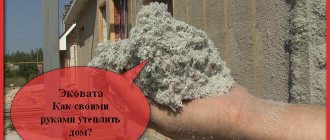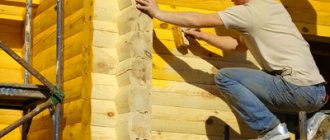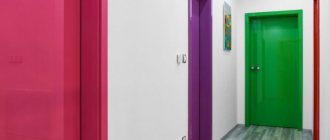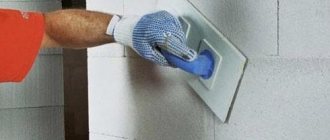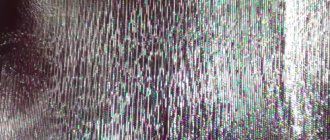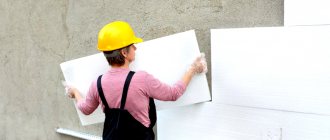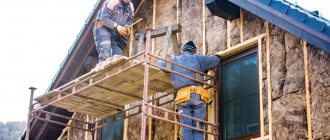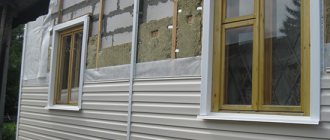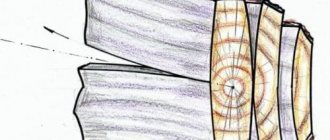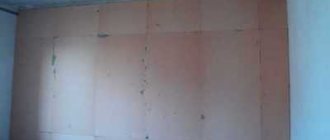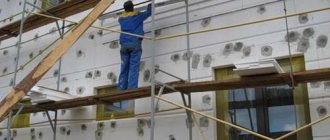No house today is built without thermal insulation. The choice of modern materials allows you to select insulation according to any parameters. When the main criterion is the price of the issue, the range of searches is limited. Among insulation materials typical for the Russian climate, ecowool is gaining particular popularity. The first installations for its production appeared here in 1993, although in Europe this material has been used for thermal insulation of residential and industrial premises since the 30s of the last century.
The construction of Scandinavian frame houses cannot be done without this practical material, and it is no coincidence: insulating residential buildings and industrial buildings with ecowool has its advantages. First of all, it is versatility. Insulation is used in partitions, walls, ceilings, roofing and enclosing structures both in private construction and on an industrial scale. The lightweight material does not weigh down the structure and is durable in use ( up to 70 years ). Several options for ecowool insulation technologies have been developed, differing in the method of its application.
Ecowool after loosening
What is ecowool
Ecowool is a cellulose insulation material, that is, it is made entirely of paper. Why is ecowool called that? I don’t know why they called it ecowool, I would call it eco-paper. Or just cellulose, cellulose insulation. But apparently it doesn’t sound as cool as ecowool. After all, marketers are cunning. But it’s easy and quick to remember.
Moreover, you can’t say that ecowool is a super environmentally friendly insulation. Yes, it is more environmentally friendly than all other insulation materials on the market: basalt, glass wool, polystyrene foam and polystyrene foam. But still there is boric acid and antiprenes.
This is not linen insulation, in which everything is environmentally friendly except the price. But at the same time, ecowool contains no substances or components capable of releasing volatile harmful substances during operation, unlike Basalt, polyurethane foam and polyurethane foam. Unlike Basalt, ecowool does not contain dangerous hazardous particles of 2-3 microns in size that can penetrate into the room even through the vapor barrier - not the most pleasant neighborhood.
On the other hand, what is the furniture in our house made of? What is our decoration made of? And this is all inside the house, and ecowool is outside, and all this does not penetrate through the films. So you definitely don’t have to worry the environmental friendliness of ecowool
What is ecowool made of? The composition of ecowool is simple: cellulose, borax and boric acid. Pleasant to the touch, soft and fluffy.
Ecowool is packaged in 15 kg bags. It is very convenient to carry it from the car to the house, and then pour it out of the bag directly into the barrel, from where it is taken by a blowing machine or a garden vacuum cleaner. We do this in a few hours.
Pros and cons of ecowool insulation
Advantages of ecowool as insulation:
- Ecowool is not limited by geometric dimensions
- Ecowool provides better sound insulation by covering all cracks and even small places
- Ecowool is warm, as it does not leave cracks
- Ecowool is more environmentally friendly than other insulation materials (there is only boric acid against pests and antiprenes against rotting)
- Kills mold on the wooden parts of our house. Protects wood
- Ecowool does not make a person itch
- Ecowool releases moisture well and tolerates waterlogging well. Ecowool absorbs moisture into the fiber, causing a slight change in thermal conductivity, while the insulating air inside it remains dry.
- Ecowool does not burn.
I have photographs in which the frame of the house burned down, and the ecowool lay untouched. If you're interested, I'll look for it, write in the comments
Disadvantages of ecowool as insulation:
- The price of ecowool is not affordable for everyone
- Installation of ecowool is not so simple
- Not all ecowool installers are equally professional. Finding a good installer is a matter of time.
That's why I work only with the best specialists in their field.
A little more should be said about the price. It's not such a disadvantage. If we look, rockwool costs 1,800 per cube, and here it’s 2,000 per cube with installation (dry installation) and 3,500 rubles per cube (wet installation). If you select only ecowool without installation, then the price of a cube will be 1,575 rubles per cubic meter. It turns out that it is also cheaper.
This is where the disadvantages of ecowool end (with proper installation).
Video description
The extent to which the positive characteristics of ecowool declared by the manufacturer correspond to reality is described in the video:
Flaws
There are no ideal materials without flaws, and ecowool is no exception. It also has its downsides.
- Shrinkage of the thermal insulation layer.
Over time, the loose fibrous material shrinks, becomes denser, loses volume, and its thermal insulation properties decrease. On horizontal surfaces, this problem is solved by making the layer thicker than the calculated one and organizing high-quality ventilation to evaporate moisture. But with vertical insulation, it will no longer be possible to fill the resulting voids.
- Installation problems.
When purchasing ecowool insulation, you should find out in advance what it is and where it is used. As well as the way in which it is laid on different structures. If you want to insulate monolithic walls or fill the cavities of a frame house, you will need special equipment and experienced operators, which are not yet available everywhere. And when insulating floors manually, the compressed material, freed from packaging, must be loosened using a drill with an attachment. This creates a lot of pervasive debris and allergenic dust.
Before installation, the material is “beaten” with a mixer Source obustroeno.com
What is better ecowool or mineral wool
Why ecowool is better than mineral wool - mineral wool:
- Noise insulation
- No cracks
- Environmentally friendly (no pharmaceuticaldehydes)
- After it, your whole body doesn’t itch (but mineral wool does the same, especially cheap ones)
- Does not melt or drip in case of fire
- Does not emit acrid smoke in case of fire
- Kills mold on the wooden parts of our house
- Does not lose its heat-insulating properties when moistened.
- There is no waste during installation.
- More technologically advanced material. For example, there is no need to comply with all dimensions and millimeters when building a frame house. Allows the use of curved boards, etc. Faster installation.
Why is mineral wool better than ecowool?
- Cheaper
- Installation is easier (with your own hands)
- There are more proven manufacturers on the market. True, many manufacturers in Russia make basalt not from mineral stone, but from steel production waste (slag).
The issue with the manufacturer is resolved simply. We need to look at the reviews. For example, we only take ecowool from Kazan from a new plant. She's always good. Do-it-yourself installation is more difficult. It is possible to blow ecowool “into the horizon” yourself, but into the walls with your own hands it is virtually impossible or ineffective.
Insulation of a frame house with ecowool
Frame houses are in first place in terms of the frequency of insulation with ecowool. I also insulated my frame with ecowool. The secret of its popularity is simple: you don’t need to be tied to the pitch of wooden elements, you don’t need to immediately bring a truckload of insulation (it fits in a gazelle), you can insulate any amount (in depth) from 30 mm to 500 mm, it makes it easier to maintain the microclimate in the frame, etc. .P.
Insulating the frame is one of our favorite tasks. Although insulating hangars is also an interesting task, it is much more difficult.
Insulation of a log house
Separately, it is necessary to say about the insulation of log houses. There are no alternatives for such houses (not counting polyurethane foam). We can easily insulate logs with ecowool, both outside and inside, and then cover them with some kind of finishing.A big plus in this case is that you don’t need to put a film inside and don’t trap moisture there, since the ecowool will let it out. The house seems to be “breathing,” although I don’t like that word.
Insulation of a block house (aerated concrete, gas silicate, foam concrete)
How to insulate aerated concrete or gas silicate houses with ecowool? Block houses are usually insulated from the outside. The sheathing is placed vertically in increments of 600-1000 mm and insulated using the wet-glue method. The concept of a breathable house also works in this case, and a vapor barrier film is usually not installed in them.
The main thing is that before insulating a block house, you need to calculate where the dew point will be in such a wall pie, since it may remain in the insulation. And although ecowool is okay with waterlogging, it is not endless.
Now let's talk about specific insulation units.
Installation methods
Ecowool is laid manually or automatically by blowing the material under pressure. For automatic spraying, both dry insulation and mixed with water are used.
The simplest and cheapest manual method is also the most ineffective. Firstly, it is used only for insulating horizontal surfaces. And secondly, with manual distribution it is difficult to create an even layer of equal density and fill all hard-to-reach places.
By using a blow molding machine to spray dry ecowool, these problems can be avoided: the insulation, supplied under pressure, lies evenly and penetrates into all cracks and recesses. But this method is only suitable for horizontal insulation and insulation of frame buildings. In the latter case, the material is blown into the cavity between the outer and inner lining through specially made or left holes.
Dry spraying of ecowool in the cavity of the frame Source thermofloc-isolatie.nl
To insulate vertical structures and sloping roofs, only the wet-adhesive automatic application method is used. The material is mixed with water to obtain a liquid suspension and blown with special installations onto the insulated surface. The natural glue lignin contained in cellulose glues the fibers to each other and to the base.
How is insulation carried out?
This video talks in detail about wet and dry insulation. I think after watching you will have no questions left about how to insulate a house with ecowool. It is better to do it with the hands of masters. I initially wanted to insulate my house with ecowool with my own hands using a garden vacuum cleaner, but the deeper I delved into the topic, the more I realized that it’s not worth insulating the walls using the dry method - it will settle. But it’s impossible to do it with wet hands.
So at the same time I ordered ecowool from a specialist using both the dry and wet methods, why spend money on a vacuum cleaner that costs 5-10 thousand and waste months of time manually blowing it into the floor.
Application area
Ecowool can be used for insulation with the same effect:
- facades - applied to the sheathing using the wet method;
- walls - when laying using the “well” method;
- walls from the inside of the room - dry or wet on a pre-prepared lattice;
- attics and roofs - performed using the dry blowing method;
- floors - insulation is carried out using the dry method, followed by covering the heat-insulating layer with plywood or OSB sheets;
- attics - roof insulation with ecowool is carried out by dry blowing. The floor can be insulated manually.
Attention: cellulose fiber wool cannot be used under floating floors or screeds.
Floor insulation
Insulating the floor with ecowool is the simplest of all activities, if done with professional installation. I insulated 200m2 of floor and attic flooring in just 5 hours! Here's the result:
The photos turned out a little cloudy because the process is quite dusty. But if you have a high-quality respirator, there will be no problems.
Many people simply spread ecowool from a bag onto the floor onto some kind of covering, and then fluff it up with a drill attachment or blow it out with a garden vacuum cleaner. It is very long and painful. Is it worth it? Let's do the math.
Calculation of the amount of ecowool for home insulation
Let's calculate the amount of ecowool for an average house of 100 m2 and one floor. The house measures 9 by 11.
Ecowool calculator:
We have (9+11)*2 = 40 sq.m. walls Multiply 40 by a wall height of 3 meters = 120 sq.m. walls
Wall insulation thickness 200 mm (150 + 50 cross). Now we multiply the area of all the walls by the thickness: 120 * 0.2 = 24 cubic meters. The density of ecowool blown into the wall is about 65 kg per cubic meter. meter. In total, we need 24*65=1560 kg of ecowool for wet insulation of our external walls.
Internal walls. Let's imagine that we have 100 sq.m. internal walls 100 mm thick. Then it turns out 100*0.1*65=650 kg of ecowool.
Total for all walls we need 1560+650 = 2210 kg needed for walls .
We count ecowool for floors. Our floor area is 9*11=99 sq.m. The thickness of the floor insulation is 200 mm. 99*0.2=20 cubic meters (trimmed a little for beauty). Don't forget that we also have an attic ceiling. We want to put 300 mm there. 99*0.3=30 cubic meters. In total, we need 50 cubic meters for both floors. The density of dry blown ecowool “to the horizon” is 35 kg per cubic meter. Total 30*35=1050 kg.
In total, to insulate a one-story frame house with a floor insulation thickness of 200 mm, a wall insulation thickness of 200 mm and an attic insulation thickness of 300 mm, we need 2210 + 1050 = 3260 kg of ecowool.
Divide by the number of 15 kg bags. 3260/15 = 218 bags of pennies. We take 230 with a reserve. It will cost about 115,000 rubles. If something is not enough, you can put 270 mm in the attic, not 300. In total, a house of 100 square meters on one floor will cost 115,000 rubles to insulate with ecowool without work. Now you understand how to calculate the amount of ecowool for your home.
But ecowool without wet insulation is not the same ecowool and loses half of its advantages. Therefore, he calculates the price of insulating this house with professional installation: 34 cubic meters per 3500 (wet installation) = 119,000 rubles. 30 cubic meters per 2000 = 60,000 rubles (dry installation in the floor and ceiling). Total 179,000 rubles . Insulation of a 100m2 house with ecowool.
Flaws
The disadvantages of cellulose wool include:
- an increase in thermal conductivity during operation, which is caused by two reasons: a decrease in volume due to shrinkage (starts from the second year of operation); increasing the humidity of the insulating layer (when wet, it dries, but not to its previous state);
- significant shrinkage on vertical and inclined structures, and therefore manufacturers recommend increasing the layer thickness by 25% compared to the calculated one, or increasing the insulation density to 65 kg/m3. Both options lead to increased consumption of material, and, consequently, to increased costs of repair work;
- weak rigidity, which requires the installation of gratings on the walls and roof of the attic;
- complex technology for performing work not only in the wet state, but also when blowing dry fibers - without special equipment it is practically impossible;
- long drying time when applied “wet” - up to 3 days;
- strong dependence of the quality of ecowool on the feedstock, which is difficult to control even among leading manufacturers.
Frequently asked questions (FAQ) on the topic of ecowool:
How long does it take to insulate a house?
We insulate a house measuring 100-200 square meters in two days. That is, we will arrive on Saturday morning, and on Monday morning your house will already be insulated. If you insulate a house of this size with your own hands and without professional equipment, it may take one or two weeks. I hope that now the question of how long it takes to insulate a house with ecowool is closed for you.
How much does it cost to insulate a house with ecowool?
I already wrote, but I’ll say it again. 2000 rubles per cubic meter (!cube, not square) of dry insulation and 3500 rubles per cubic meter of wet insulation (it is more technologically advanced and more complex).
Is there some kind of calculator?
Only manual! Here I have given you a calculation method, everyone can easily and quickly calculate the volume of ecowool they need!
What is the wet insulation method?
The wet method (more precisely, the wet-glue method) of insulation consists of using a special machine in which ecowool, water and glue are mixed, and then it delivers it under pressure to the desired location. In my opinion, cotton wool can only be applied to the walls using the wet method, since if you use the dry method, the ecowool will definitely shrink over time.
Does ecowool shrink?
Does not give! But there is one thing. Ecowool does not shrink with proper installation: with wet insulation of vertical coverings (the horizon can be done dry), as well as with the direct hands of the installer (so call people with experience, for example, us).
What should be the density of ecowool for blowing?
If we are talking about flooring, then the density should be about 35 kg per cubic meter, if we are talking about wall insulation, then the density of ecowool should be 65-75 kg per cubic meter.
Is it possible to insulate a house with ecowool in winter?
If the perimeter of the house is closed, then in winter it can be insulated down to -15.
How much water should there be in ecowool? (humidity)
It takes 30 liters of water per cube of cotton wool.
Ideal wall and floor pie under ecowool
The ideal pie: ventilated facade - MDVP - ecowool - kraft vapor-limiting paper (or PE) - lathing - plasterboard.
How to plaster the outside using ecowool?
Plastering will not work. But you can plaster using MDVP
What is the durability of ecowool?
During the entire period of using ecowool (and it has been used abroad for quite some time) it was not noticed that anything happened to ecowool. So you don’t have to worry about its durability as insulation.
How much does a 15 kg bag of ecowool cost?
A bag of ecowool comes out at current prices of approximately 450-500 rubles. You can buy ecowool at special factories. But many factories make very low-quality raw materials, so you also need to know where you can buy and where not.
What is the sufficient thickness of an ecowool layer in mm for a permanent residence house?
For a permanent residence house, the thickness of ecowool is sufficient: 200-250 mm for the floor, 200 for the walls, 250-300 for the attic or attic. Media is becoming more expensive, so it’s better not to skimp on insulation.
For a dacha, the thickness of ecowool is sufficient: 150 mm in the floor, 100 mm in the walls, 150 mm in the attic.
Is a ventilation gap (vent gap) necessary in a wall with ecowool?
A ventilation gap in a pie with ecowool is optional, but it depends (as with other insulation materials) on the complete wall pie and especially on the facade materials. If there is siding on the outside, then a ventilation gap is not needed. If the exterior decoration of the facade is wooden, then you cannot do without a ventilation gap. That is, there are no special rules regarding ecowool, unlike the same mineral wool or glass wool, all “pies” are classic.
Is it possible to insulate foam blocks from the outside using the wet method?
Yes, sure. Typically, foam blocks (aerated concrete and gas silicate blocks as well) are insulated with ecowool on the outside with a sheathing about 100 mm thick. After which the facade is made from siding (which is most convenient).
How much does it cost to insulate a 200m2 house with ecowool?
Depends on the area of the walls and floor, here I have given the calculation for a house of 100 m2. But if it’s difficult for you, please contact us in the comments, by email or by phone - we will calculate it for you.
Do you need a moisture-proof film for ecowool on the outside?
Yes, of course, as with any other insulation, a moisture- and wind-proof film is needed on the facade after the ecowool. The fact is that it protects a wooden or other facade and insulation not only from moisture, but also from blowing, and this is no less important.
Do you need a vapor barrier film with ecowool inside?
Here opinions differ. Many insist that PE is not needed inside, but I am still in favor of having it installed. Classic frame house pies all contain a vapor barrier film, and I am against inventing bicycles.
Is it possible to insulate a bathhouse?
Yes. It is not as afraid of moisture as basalt and mineral insulation and easily removes it both outside and inside. The only thing is that you need to install the vapor barrier very well in this case.
Does ecowool burn?
According to the certificate, ecowool is classified into group G2 (moderately flammable), as well as B2 (moderately flammable) and D2 (with moderate smoke-generating ability) and T2 (moderately toxic). In practice, ecowool does not burn at all; there are many experiments on the Internet with attempts to set it on fire, all unsuccessful. She only burns a little and nothing else. Ecowool does not burn due to a special additive: five- or ten-water borax. When ecowool is ignited, water is released from the borax, thereby helping to lower the temperature in the hearth and attenuate it. After this, a ceramic layer is formed on the surface of the ecowool, which prevents the fire from spreading deeper. In addition, ecowool is poorly blown by the wind, which also gives it a better chance of fighting fire.
And here are photos from the real object. I found it, as promised at the beginning of the post. The result is that ecowool does not burn :
Plywood and ecowool
How do plywood and ecowool combine? The situation with it is the same as with OSB-3 (I described above how best to get out of this situation)
How much ecowool should there be in mm?
Ceiling, floor: 200mm or 250mm Walls: 150mm or 200mm Attic: 200mm or 250mm Attic: 250mm or 300mm
Is ecowool toxic?
During the use of ecowool, no consequences for human health were identified. The fact is that both the antiseptic (boric acid) and the fire retardant (borax) are natural, sparingly soluble minerals that cannot release anything into the air during operation. Even allergy sufferers can live in a house insulated with ecowool.
The fastest insulation method. Which?
The fastest method of insulation is the wet-glue method. If you need to insulate your house very quickly, then hire specialists and everything will be done very quickly.
Is it possible to use drywall with ecowool?
Drywall with ecowool can be used. The only thing is that I would first give the ecowool a month to release excess moisture into the environment, and then I would cover it with gypsum board (plasterboard). It is also possible to successfully sew up walls insulated with wet ecowool material GSP and DSP.
What about ecowool with mice and insects? Do mice grow in ecowool?
Mice do not eat ecowool; it is inedible for them. True, there are rumors that they can still make passages in ecowool if they are allowed into it. But this can be said about any known insulation material: basalt wool, glass wool or polystyrene foam.
The main thing in the fight against mice: do not let them inside, and for this purpose steel mesh is used at the points of access to the wall (in the ventilation gap), as well as closing the access to the ceiling from below. It is also advisable to have a cat, this eliminates all possible problems.
Films and ecowool
If your house does not have rigid slab sheathing, but simply a film stretched on the outside, then insulating it from the inside with ecowool will be unrealistic. Ecowool must stick to something and this something must be hard: board, MDVP, etc. If you want to make a vapor barrier film between the main layer of insulation and an additional cross layer, then you also cannot make a cross layer of ecowool. It is better to move the vapor barrier inside the house, up to both layers of insulation. Moreover, you can also hide pipes and communication wires under the film.
Is it possible to use kraft paper in ecowool pies?
Indeed, kraf paper is very often used with ecowool. It is used by adherents of the “partial vapor barrier” method. That is, the kraft paper holds back some of the steam, and lets the rest into the ecowool. And the ecowool releases it further out. Plus, kraft paper retains dust from ecowool (if it suddenly wants to dust).
The main thing is not to use kraft paper in a pie with OSB on the outside. Then the steam will not be able to escape from the ecowool and will remain in it. So the option of using kraft paper in a pie without OSB is possible.
Is ecowool hazardous to health?
In fact, in the modern construction market, almost all products are dangerous in some way. Therefore, it is normal not to trust, but to check and investigate. As far as I could understand from my research, ecowool is not hazardous to health .
Boric acid does not get into the air (especially if we install a vapor barrier on the walls, but I still recommend installing it) plus the pores of ecowool are large and there are no small particles that can get into a person’s lungs (unlike basalt insulation). So the answer to the question: “ Is it dangerous to inhale ecowool?” " - No. But it’s still better to work with it wearing a mask, as with any other material, such as putty and other similar materials. It is better not to inhale anything unnecessary, even harmless.
A good video about ecowool that addresses this issue:
And this is a video about what ecowool looks like after 10 years (nothing has settled). So the answer to the question: does ecowool settle - no.
Briefly about the main thing
The very name of ecowool hints that it is an environmentally friendly and harmless insulation material. In fact, one can argue with this statement, as well as with the fact that this is one of the cheapest and most effective thermal insulation materials.
But when compared with expanded polystyrene or mineral wool, it actually has many impressive advantages, in particular - excellent heat capacity, vapor permeability, resistance to harmful biological factors, and a high degree of sound insulation.
Disadvantages can be found in any material, the main thing is that they are not critical and can be leveled out by following the installation technology. In this regard, ecowool is a very worthy insulation material.
Ratings 0

